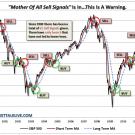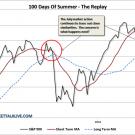by Lance Roberts, Street Talk Live
For some time now we have been warning about the danger to portfolios given the deteriorating fundamental, economic and technical backdrop in the markets. Our warnings, for the most part, have been ignored as individuals continue to chase stocks in hopes that "this time will be different", and somehow, stocks will continue to ramp higher even though all three support legs are weakening. Currently, it is the imminent arrival of the next round of Quantitative Easing (QE) that keeps "hope" elevated but further Central Bank intervention is unlikely in the near term leaving the markets at risk of a further correction.
My job is to analyze the trend of the data, both economic, fundamental and technical, to build a frame work of possibilities and probabilities about what might happen soon. Like any good poker player before making a "bet," which requires putting my capital at risk of loss, I want to make sure that the odds are in my favor of winning. If I am highly confident of success - I bet a lot. If not - I do not. The same philosophy goes into managing money. Wall Street tells you to be invested all the time because that is how they make money. However, the reality is that investing is very akin to playing poker - you are making bets today based on the possibilities of some future outcome.
The reason for this framework is that I have been negative on the markets since early April. The weight of evidence has clearly been negative. While the mainstream media continues to look for glimmers of "hope" - hope is not an effective investment strategy. However, when the flow of data changes and price action becomes more constructive - my outlook will also. (Read "Thoughts On Long Term Investing")
For new readers, welcome to the site, here is a brief compendium of previous articles which have been guiding our readers through the current market correction process that began in early April:
- April 9th - The Correction Has Started
- May 21st - Sell Signal Confirmed - Initial Targets Set
- June 6th - Forecasting The Rebound And Bottom
- June 26th - June Rally Complete - Summer Sell Off Ahead?
- July 3rd - Coming This Fall The Best Time To Invest
 Major Sell Signal Is In
Major Sell Signal Is In
This bit of history leads us to our latest, and most important, sell signal to date. With the economy continuing to weaken, corporate earnings, showing severe signs of strain and the Eurocrisis emerging once again - the risk at the moment is clearly to the downside. The continued deterioration, in both the fundamental and technical frameworks, has significantly increased the risk of further equity market declines.
The decline in the markets on July 24th pushed the two main moving averages that we follow into negative territory initiating a major SELL signal for the markets. These major sell signals should not be ignored. The first chart plots our two moving averages relative to the S&P 500 over the last 12 years. During this time frame there has only been 7 "sell" and 6 "buy" signals. As with all investment strategies and disciplines there is always the possibility of getting a false signal. The same is true for this particular indicator. Since 1930, there have been a total of 51 major "sell" signals of which 9 gave a false reading translating into a 17.6% failure rate. As I said, no indicator is perfect, but as an investment manager I am willing to make investment decisions based on an indicator that has an 82% success rate.
More importantly, as shown in the chart, this strategy helped us avoid the bulk of the last two recessionary market debacles. The problem is that while it is easy to assume that the current correction could be shallow, like previous two summers as the Federal Reserve stepped in to prop up asset prices, there is always a chance that it could be a much bigger correction. Following the signals previously would have limited downside risk while keeping you primarily invested in for the majority of bullish trends.
 The next chart shows the similarities of the 2011 and 2012 markets. In both cases rallies in June, post a May decline, led to sloppy sideways trading in July. The major "Sell" signal occurred on August 5th of 2011 as the markets began a steep sell off. While there is no guarantee that the market is about to plunge towards the 1200-1250 level this August - the striking similarities of market action certainly does suggest a more cautionary stance be taken.
The next chart shows the similarities of the 2011 and 2012 markets. In both cases rallies in June, post a May decline, led to sloppy sideways trading in July. The major "Sell" signal occurred on August 5th of 2011 as the markets began a steep sell off. While there is no guarantee that the market is about to plunge towards the 1200-1250 level this August - the striking similarities of market action certainly does suggest a more cautionary stance be taken.
Sell Into The Bounce
Technical signals must be put into "context" based on current market conditions. In order to strip out the "noise" in our analysis we use weekly instead of daily price data. This smoothing of the daily data allows for better clarity of the trends in the market. However, due to this smoothing process by the time a signal is given the markets are generally overbought, or oversold, on a daily basis and are generally close for a reflexive bounce. That bounce should be sold into.
The problem for most investors is that when the market bounces in order to correct the short term oversold condition they assume that the "sell signal" was incorrect. More than 80% of the time, as our data shows, the market will bounce and then decline to lower levels. Therefore, the rules are simple:
- In negative trending markets - sell rallies.
- In positive trending markets - buy dips.
The technical and fundamental setup is currently a negatively trending market. It is very likely that, in the current environment, we will retest the May lows, if not ultimately set new lows, in August. Those lows will likely coincide with further weakness in the economy which should be the perfect setup for the Fed to launch a third round of Quantitative Easing. Should that occur that will provide the best opportunity to take the cash we are holding in reserve and increase equity exposure at lower price levels.
The caveat to all of this is if the Fed acts early with QE 3 at the end of this month. I don't think this is likely but it is a possibility. In that event the boost to asset prices will reverse the current signal and we will need to add equity exposure back into portfolios. However, until then, with the major "sell" signal in place it is more important to remain cautious, and conserve investment capital, until a better risk/reward opportunity presents itself.











